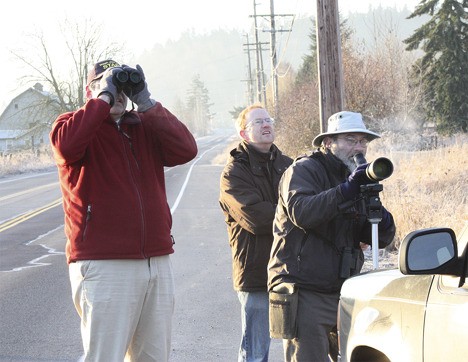It’s a little more than an hour into the Rainier Audubon Society’s annual Christmas Bird Count on Sunday when the identification and recording of South King County’s feathered species hits a minor snag.
“We’ve got our first dilemma of the day,” Jeff Cohen says, looking up from his Pentax 65-mm spotting scope.
He looks across a partially flooded field – located just off State Route 167 and 272nd Street South, by the Smith Brothers Farms – where a lone bird hides in the grass alongside a still frozen body of water.
“He keeps poking his head up, but that’s all I can see,” Guy McWethy, another of the Audubon volunteer counters, adds.
“It’s a Dowitcher, but we’re not sure if it’s a long-billed or short-billed,” Cohen says.
Although not necessarily a rare bird, the Dowitcher is still a find for this area. So far this morning, the count has included several crows, Starlings, a handful of Killdeer, a hawk and a pair of Great Blue Herons, but this is the first bird that provides a challenge, which has the counters excited.
Cohen points out the Dowitcher, a shore bird that feeds on insects, mollusks, crustaceans and worms along the water’s edge, in the Society’s field identification guide. The differences between the long-billed and short-billed are minute. Despite the name, the length of the bill is not an accurate way to tell the difference, Cohen explains. Instead they look for the tiny differences in coloring – a banding on the long-billed species, as opposed to spotting on the short-billed. The only other way, a more reliable difference, is the bird’s song. With this particular bird half-hidden in grass and not in a singing mood, the point is moot.
“I don’t feel comfortable calling it either way,” Cohen says.
McWethy, however, is determined.
“He’s a bulldog,” Cohen says.
Eventually the pair, along with fellow counter Tim Brennan, decide that they’ve seen enough to classify it a long-billed.
For the counters, the Dowitcher is just one of 61 species of bird they will catalog in the Rainier Audubon Society’s Section 6 South counting zone – which begins on the west ridge of the valley and runs east to SR 167. On the north the zone begins at 272nd Street South and continues to SR 18 in the south.
Team effort
The trio is not alone. All over South King County, including the communities of Maple Valley, Renton, Kent and Federal Way, teams of birders are out on this crisp, clear, winter morning counting, identifying and cataloging.
For the past three years, Cohen has been counting birds during the holidays in Sector 6 South. Today, the weather is cooperating. It’s cold, but sunny with clear skies and more importantly – no rain.
“I don’t know the exact history of the count, but some places have done it for more than a 100 years,” Cohen says. “It started on the East Coast, where I understand it was an alternative to hunting.”
Since then it’s become an opportunity to catalog bird species nationwide and gather data on long-term trends on bird populations.
“It’s supposed to be done within a couple weeks of Christmas, and there are about 35-40 counts done in Washington,” Cohen says. “They’re done all over the country and in Canada.”
“One of the reasons they do these at this time of the year is because much of the data is used for long-term trends,” McWethy adds. “So this is done every year during times of no migration. The reason we do it at this time of the year is because the birds are pretty much set in for the winter right now, they’re not moving around. So the theory is, if you get everybody in the country counting birds right now, we can get an accurate count.”
McWethy continues:
“You see the bird population going down in a particular area or going up. Unfortunately most of the time it’s going down.”
After a day in the fields of South King County, McWethy, Cohen and Brennan turn in their count, where it will be added to the Rainier Audubon’s total count for South King County.
Although the totals have yet to be tallied, initial results of the count offered several significant finds, including a Greater White-Fronted Goose near Maple Valley and a Red Shouldered Hawk found at the Kent Ponds
According to Cohen, who has been bird watching since he was 14, the count is important for several reasons and ties a sense of purpose to what for many is just a hobby. Cohen said he finds his joy just getting out in the fields.
“You can really get into it at many different levels,” he says. “Some people keep track of the birds that come to their own backyard. Some people will travel cross country for a bird.
“I just think it’s fun,” Cohen continues. “I love studying birds. I get out and get to explore new areas and combine it with the photography and hiking.”
Currently the count list is being compiled by the Rainier Audubon Society. More information on the count and the Society can be found at www.rainieraudubon.org.



